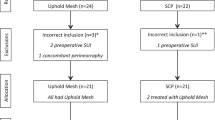Abstract
Purpose
Pelvic organ prolapse (POP) impairs quality of life (QoL) due to vaginal bulge symptoms and changes in bladder/bowel and sexual function. The effect of alloplastic meshes on QoL is still being discussed. The purpose of this study was to prospectively evaluate the effect of mesh implantation on QoL and sexual function over 1 year.
Methods
289 women with cystocele > stage I were included in this prospective multicenter study, with nine hospitals participating (ClinicalTrials.gov NCT01084889). Mesh exposures rates and pelvic floor-related QoL using the validated German version of the p-QoL questionnaire were evaluated as the primary endpoints. Based on a single-sided binominal test with α = 0.05 and a power of 0.80, a sample size of 225 for the mesh exposures was calculated. The mesh used was a 6-arm mesh with titanium coating (TILOOP® Total 6, sponsor pfm medical ag, Germany). Preoperative data were compared to 6 and 12 months postoperative data, using Wilcoxon test.
Results
The mean age of the patients was 67 years (min 43, max 87). All domains of QoL improved significantly compared after surgery: mean prolapse score dropped from 73.7 to 19.4 after 6 and 16.2 after 12 months (p < 0.001). Sexual function also improved significantly. The rate of dyspareunia was lower at follow-up.
Conclusions
In this prospective trial, a significant positive effect of mesh implantation on pelvic floor-related QoL was observed. These findings remained stable 1 year after surgery with further improvement. This trial adds further data to the ongoing discussion on the role and risk of meshes in POP surgery.



Similar content being viewed by others
Abbreviations
- POP:
-
Pelvic organ prolapse
- QoL:
-
Quality of life
- FDA:
-
US food and drug administration
- eCRF:
-
Electronic case report form
- MCID:
-
Minimal clinically important difference
- POP-Q:
-
Pelvic organ prolapse quantification system
References
Jelovsek JE, Maher C, Barber MD (2007) Pelvic organ prolapse. Lancet 369(9566):1027
Karabulut A, Ozkan S, Koçak N, Alan T (2014) Evaluation of confounding factors interfering with sexual function in women with minimal pelvic organ prolapse. Int J Gynaecol Obstet 127(1):73–76
Maher C, Feiner B, Baessler K, Schmid C (2013) Surgical management of pelvic organ prolapse in women. Cochrane Database Syst Rev 4:CD004014. doi:10.1002/14651858.CD004014.pub5
FDA Safety Communication (2013) Update on serious complications associated with transvaginal placement of surgical mesh for pelvic organ prolapse. http://www.fda.gov/medicaldevices/safety/alertsandnotices/publichealthnotifications/ucm061976.htm
Köckerling F, Schug-Pass C (2014) What do we know about titanized polypropylene meshes? An evidence-based review of the literature. Hernia 18(4):445–457. doi:10.1007/s10029-013-1187-3 (Epub 2013 Nov 20. Review)
Digesu GA, Khullar V, Cardozo L, Robinson D, Salvatore S (2005) P-QOL: a validated questionnaire to assess the symptoms and quality of life of women with urogenital prolapse. Int Urogynecol J Pelvic Floor Dysfunct 16(3):176–181
Lenz F, Stammer H, Brocker K, Rak M, Scherg H, Sohn C (2009) Validation of a German version of the P-QOL questionnaire. Int Urogynecol J Pelvic Floor Dysfunct 20(6):641–649. doi:10.1007/s00192-009-0809-x
Brosteanu O, Houben P, Ihrig K, Ohmann C, Paulus U, Pfistner B, Schwarz G, Strenge-Hesse A, Zettelmeyer U (2009) Risk analysis and risk adapted on-site monitoring in noncommercial clinical trials. Clin Trials. 6(6):585–596. doi:10.1177/1740774509347398
Norman GR, Sloan JA, Wyrwich KW (2003) Interpretation of changes in health-related quality of life: the remarkable universality of half a standard deviation. Med Care 41(5):582–592
Scientific Committee on Emerging and Newly Identified Health Risks (SCENIHR) (2015) Preliminary Opinion on the safety of surgical meshes used in urogynecological surgery. European Union, 2015. ISSN 1831-4783 ISBN 978-92-79-43917-9. doi:10.2772/63702
Barber MD, Brubaker L, Nygaard I, Wheeler TL 2nd, Schaffer J, Chen Z, Spino C (2009) Pelvic floor disorders network. Defining success after surgery for pelvic organ prolapse. Obstet Gynecol 114(3):600–609. doi:10.1097/AOG.0b013e3181b2b1ae
Zyczynski HM, Rickey L, Dyer KY, Wilson T, Stoddard AM, Gormley EA, Hsu Y, Kusek JW, Brubaker L (2012) Urinary incontinence treatment network. Sexual activity and function in women more than 2 years after midurethral sling placement. Am J Obstet Gynecol 207(5):421.e1–6
Rogers RG, Kammerer-Doak D, Darrow A, Murray K, Olsen A, Barber M, Qualls C (2004) Does sexual function change after surgery for stress urinary incontinence and/or pelvic organ prolapse? A multicenter prospective study. Am J Obstet Gynecol 191:206–210
Barski D, Otto T, Gerullis H (2014) Systematic review and classification of complications after anterior, posterior, apical, and total vaginal mesh implantation for prolapse repair. Surg Technol Int 24:217–224
Marschke J, Hengst L, Schwertner-Tiepelmann N, Beilecke K, Tunn R (2015) Transvaginal single-incision mesh reconstruction for recurrent or advanced anterior vaginal wall prolapse. Arch Gynecol Obstet 291(5):1081–1087. doi:10.1007/s00404-014-3497-9 (Epub 2014 Oct 4)
Acknowledgments
We thank Mr. Arim Shukri for the statistical analysis and Mr. Lutz Sternfeld for the external monitoring.
Author information
Authors and Affiliations
Corresponding author
Ethics declarations
Funding
The study was sponsored by pfm medical ag, Cologne, Germany.
Conflict of interest
We have had full control of all primary data and agree to allow the Journal to review our data if requested.
Rights and permissions
About this article
Cite this article
Farthmann, J., Mengel, M., Henne, B. et al. Improvement of pelvic floor-related quality of life and sexual function after vaginal mesh implantation for cystocele: primary endpoint of a prospective multicentre trial. Arch Gynecol Obstet 294, 115–121 (2016). https://doi.org/10.1007/s00404-016-4014-0
Received:
Accepted:
Published:
Issue Date:
DOI: https://doi.org/10.1007/s00404-016-4014-0



